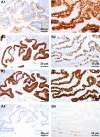Clinicopathological Characteristics of Pseudomyxoma Peritonei Originated from Ovaries
- PMID: 32904568
- PMCID: PMC7457389
- DOI: 10.2147/CMAR.S264474
Clinicopathological Characteristics of Pseudomyxoma Peritonei Originated from Ovaries
Abstract
Objective: This study aims to demonstrate clinicopathological characteristics and immunohistopathological phenotypes of pseudomyxoma peritonei (PMP) originated from ovaries.
Methods: The primary origin of PMP was explored by reviewing H&E sections retrospectively and performing a series of immunohistochemical staining on CK7, CK20, CDX2, CEA, Villin, SATB2, CA125, ER, PR, and MUC.
Results: Among 310 PMP patients, a few originated from extra-appendix, whereas eight cases were of ovarian origin (2.6%), including three teratoma-associated ovarian mucinous tumors and five primary ovarian mucinous tumors with spontaneous or iatrogenic rupture, respectively. Most peritoneal metastases were acellular mucin or low-grade mucinous carcinoma peritonei (6/8, 75%), while the rest were high-grade mucinous carcinoma peritonei (2/8, 25%). Tumors were positive for CK20, CDX2, CEA, and Villin. SATB2 was specifically diffuse positive in teratoma-associated ovarian mucinous tumors, and negative in primary ovarian mucinous tumors. Differential expression of MUC was observed in these tumors.
Conclusion: PMP of ovarian origin is extremely rare. The precise diagnosis requires serial sections of the appendix or suspicious tissue to exclude appendiceal mucinous neoplasms, as well as comprehensive analysis of clinical features, surgical findings, histopathological characteristics, and immunohistochemistry on specific biomarkers.
Keywords: PMP; mucinous tumor; ovary; pseudomyxoma peritonei.
© 2020 Yan et al.
Conflict of interest statement
The authors report no conflicts of interest in this work.
Figures




Similar articles
-
Histological origin of pseudomyxoma peritonei in Chinese women: clinicopathology and immunohistochemistry.World J Gastroenterol. 2011 Aug 14;17(30):3531-7. doi: 10.3748/wjg.v17.i30.3531. World J Gastroenterol. 2011. PMID: 21941421 Free PMC article.
-
Ovarian mature teratomas with mucinous epithelial neoplasms: morphologic heterogeneity and association with pseudomyxoma peritonei.Am J Surg Pathol. 2008 May;32(5):645-55. doi: 10.1097/PAS.0b013e31815b486d. Am J Surg Pathol. 2008. PMID: 18344868
-
Ovarian mucinous tumors associated with mature cystic teratomas: morphologic and immunohistochemical analysis identifies a subset of potential teratomatous origin that shares features of lower gastrointestinal tract mucinous tumors more commonly encountered as secondary tumors in the ovary.Am J Surg Pathol. 2007 Jun;31(6):854-69. doi: 10.1097/PAS.0b013e31802efb45. Am J Surg Pathol. 2007. PMID: 17527072
-
Pseudomyxoma peritonei and selected other aspects of the spread of appendiceal neoplasms.Semin Diagn Pathol. 2004 May;21(2):134-50. doi: 10.1053/j.semdp.2004.12.002. Semin Diagn Pathol. 2004. PMID: 15807473 Review.
-
Ovarian Causes of Pseudomyxoma Peritonei (PMP)-A Literature Review.Cancers (Basel). 2024 Apr 9;16(8):1446. doi: 10.3390/cancers16081446. Cancers (Basel). 2024. PMID: 38672528 Free PMC article. Review.
Cited by
-
Accidental discovery of appendiceal carcinoma during gynecological surgery: A case report.World J Clin Cases. 2022 Aug 6;10(22):8040-8044. doi: 10.12998/wjcc.v10.i22.8040. World J Clin Cases. 2022. PMID: 36158468 Free PMC article.
-
Pseudomyxoma peritonei originating from intestinal duplication: A case report and review of the literature.World J Clin Cases. 2021 Sep 6;9(25):7459-7467. doi: 10.12998/wjcc.v9.i25.7459. World J Clin Cases. 2021. PMID: 34616812 Free PMC article.
-
Pseudomyxoma peritonei arising from mature ovarian teratoma, a rare entity: Report of six cases and review of current literature.Gynecol Oncol Rep. 2024 Aug 18;55:101488. doi: 10.1016/j.gore.2024.101488. eCollection 2024 Oct. Gynecol Oncol Rep. 2024. PMID: 39308901 Free PMC article.
-
Multimodal diagnostic strategies and precision medicine in mucinous ovarian carcinoma: a comprehensive approach.Front Oncol. 2024 Jul 8;14:1391910. doi: 10.3389/fonc.2024.1391910. eCollection 2024. Front Oncol. 2024. PMID: 39040449 Free PMC article. Review.
-
Rare occurrence of pseudomyxoma peritonei (PMP) syndrome arising from a malignant transformed ovarian primary mature cystic teratoma treated by cytoreductive surgery and HIPEC: a case report.World J Surg Oncol. 2022 Mar 11;20(1):78. doi: 10.1186/s12957-022-02548-8. World J Surg Oncol. 2022. PMID: 35272690 Free PMC article.
References
-
- Ronnett BM, Shmookler BM, Sugarbaker PH, et al. Pseudomyxoma peritonei: new concepts in diagnosis, origin, nomenclature, and relationship to mucinous borderline (low malignant potential) tumors of the ovary. Anat Pathol. 1997;2:197–226. - PubMed
LinkOut - more resources
Full Text Sources
Research Materials
Miscellaneous

